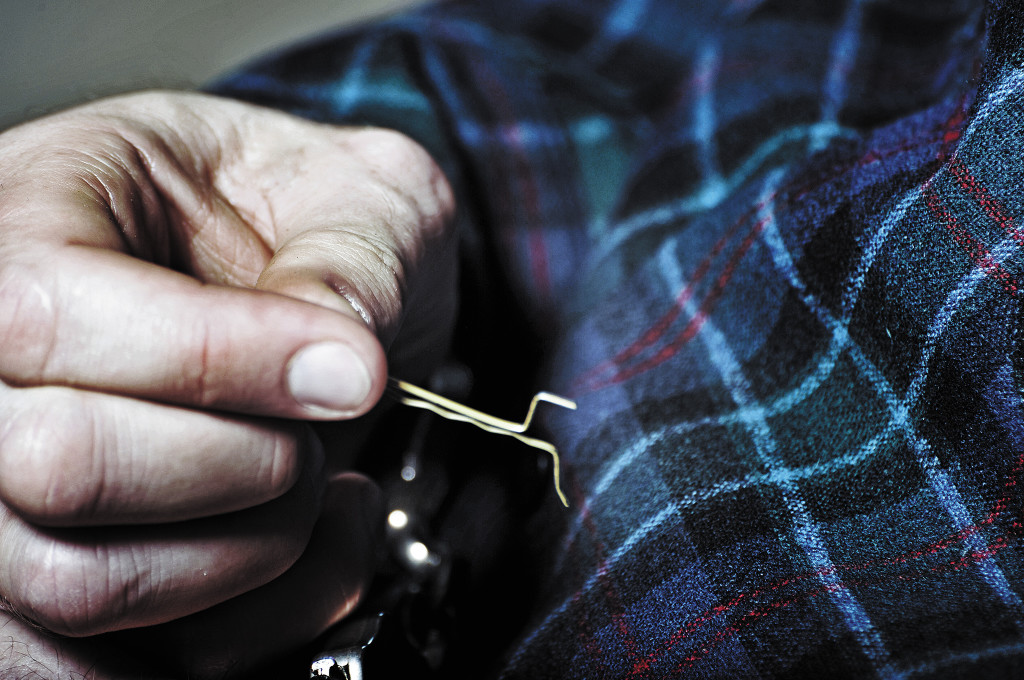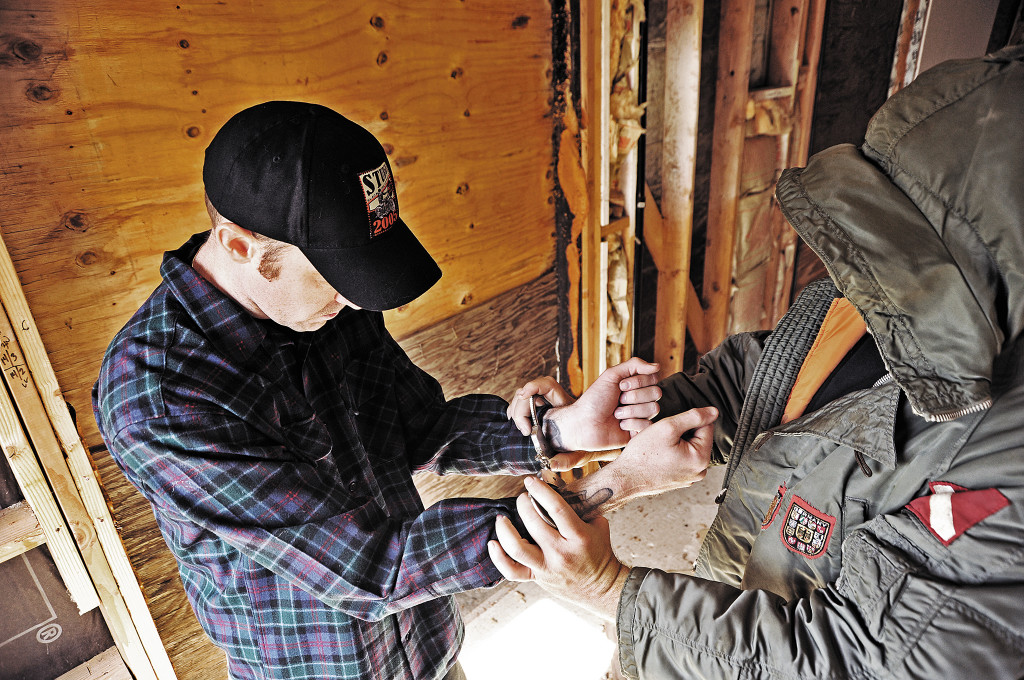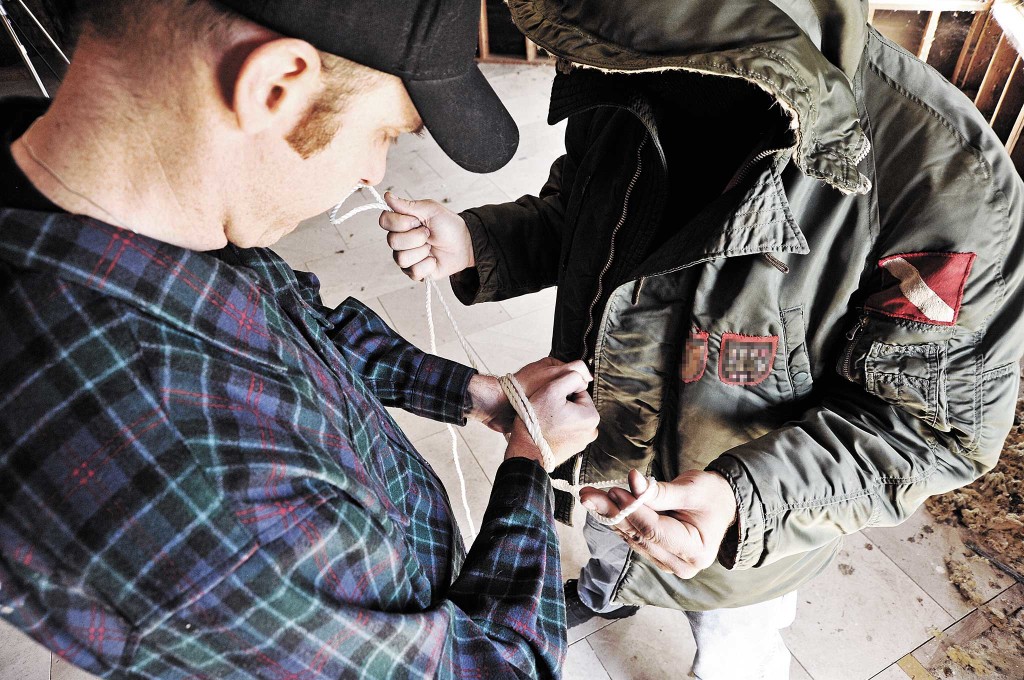RECOIL OFFGRID Preparation Techniques to Break Free From a Kidnapper’s Restraints
In This Article
Kidnappings are an all-too-real situation both at home and abroad. Whether you’re an overseas contractor, a deckhand on a freighter in unfriendly waters, or a tourist in a foreign country who wandered into the wrong part of town, the unfortunate reality is that the fate of unlawful abductions and incarcerations can often be the worst kind. What’s even more discouraging is that the availability of training for the average person to deal with these kinds of situations is limited at best.
Assume neither Liam Neeson nor anyone else is going to find and free you. You’re on your own. So in the event you are taken by unknown assailants and restrained, what can you do to escape?
The variables that can occur in these situations are only limited by your imagination. You may be blindfolded, gagged, partially or fully undressed, in the same room with your captors or alone, and bound in various different ways with various different materials. Since we can’t cover every possibility, we’ve spoken to a few experts on what to do to free yourself from common restraints (handcuffs, duct tape, rope, and zip ties) and staged a few situations to demonstrate ways to possibly break out of these restraints. Take a look at these methods and arm yourself with the self-reliance that could very well save your life.

Kevin Reeve — whose company, onPoint Tactical LLC, offers courses in tracking, survival, escape, and evasion skills — says kidnappings are typically motivated by three factors: profit, political reasons, and ideological reasons (such as religion). You may not realize it, but you may fit one of these criteria just by traveling in an unsafe area. Take the time to familiarize yourself with where you are going. Know where the closest military bases, embassies, and consulates are located. After you escape, you will need to find a safe haven that’ll offer asylum and enable you to contact help. If you are captured within the United States, finding a fire station or police station would also suffice; however, these facilities may provide little protection in foreign countries.
Landmarks can help you navigate. For example, if you are going to Paris, finding the Eiffel Tower on the horizon and knowing where it is in relation to safe locations is recommended. See the article “No Compass, No GPS, No Problem” in the Winter 2014 issue of OFFGRID. The U.S. Department of State also offers travel advisories and warnings on its website (www.state.gov). Familiarize yourself with these before traveling abroad. Knowing danger zones and avoiding a potentially life-threatening situation to begin with is the most effective tool you can have.
Reeve also suggests carrying small and discreet tools that can help facilitate an escape, as well as having them in several tiers if some are confiscated. “I have a lock pick set in my pocket, one in the back of a search-and-rescue belt, and then I have other picks sewn into pads on my clothing. If they take my shoes and belt, I’ll still have three tiers: pocket, belt, and inside the clothes. There are three or four restraint escape devices that I also carry. Usually a handcuff key, a V cutter on a string, and a diamond rod, which is a diamond-coated wire about a 1⁄32 of an inch thick and 3 inches long,” Reeve says. This may seem excessive, but in survival situations it’s all about having as many advantages as possible. We’ll discuss resources that sell these tools in a bit.
Time is of the essence. “As time progresses, the quality of your incarceration increases,” says Reeve. The sooner you can escape, the better your odds of survival. The more time passes, the more difficult escape becomes.
When you are forced to surrender to your captors, Reeve suggests “passive resistance” techniques to help stack the odds in your favor without your captors knowing it. Do not act threatening to your kidnappers or look them in the eyes. “Generally the more compliant you are at this stage, the better it is for you,” says Reeve. You can also try to persuade your captors to bind your hands where you can see your restraints and therefore have an easier time breaking out of them. “Present your hands in front of you hoping your captors will accept that arrangement,” says Craig Sawyer, a former Navy SEAL with experience in running high-threat mobile security operations.
Orient yourself. Are you alone? If so, what is in the room that you can reach and use to escape? What are you bound with? If you can’t see it, feel it to get a better idea. Does anything around you have hard or sharp edges, such as a closet track, door, wall corner, or table? Is there anything on the floor such as paper clips or pens? You have to use everything at your disposal that may help free you.
Handcuffs tend to be a bit generic. One key may work on a variety of different handcuff types. “Smith & Wesson Model 100 handcuffs account for about 60 percent of the market. The reason is because people have to transfer prisoners and they don’t want a special key for each one,” says Reeve. First, if your cuffs are not in front of you, try to bring them out in front of you. “This is far better for numerous reasons: increased mobility, the fact that you can easily see and manipulate your restraints, your reach is increased, you can fire weapons if the opportunity arises, etc.,” says Sawyer.
Arm and torso length varies from person to person, and it may not be possible for you to bring the cuffs in front of you. If your hands are stuck behind your back, you’ll need to figure out the orientation of the locking mechanism. Is the keyhole facing your hands or your elbow? Is the cuff double or single locked? Once you establish this, you’ll have a better understanding of how to manipulate the lock.

A bobby pin or small, thin piece of metal can be fashioned into a lock pick by bending one end of it into a shape that...
The next step is finding or making a tool. Assuming you don’t have a cuff key available, a bobby pin or small, thin piece of metal can be fashioned into a lock pick by bending one end of it into a shape that resembles a hand crank. You can use the keyhole to help bend it into the appropriate shape. A thin piece of metal called a shim can also be used. The metal clip of a pen cap can be broken off and used as a shim. If you’re double locked, you’ll have to use a bobby pin or something like it to open the cuffs. If you’re single locked, you can shim or bobby pin the lock open.
Another method is try to slide your hands forward toward your captor as your cuffs are applied with the intention of them being fastened around your forearms. This way the cuffs will be closed loosely, and you may have enough room to pull your hands through the opening. Enlarging your wrists may also cause the cuffs to be closed loosely. “The technique is to align your wrists and flex them in a manner that causes the restraints to be loose once you relax and change the angle. Basically, put your wrists next to each other and make fists. Once the restraints are applied, relax, realign, and attempt to slip out,” says Sawyer.

Slide your hands forward toward your captor as your cuffs are applied with the intention of them being fastened around...
To escape using some sort of lock-picking device takes some practice. By using a diamond rod, you may also be able to saw through the cuff chains by working it back and forth. With enough practice, you can use any of these techniques to escape in a reasonable amount of time. Having a diagram of the internal workings of cuffs or cutaway cuffs that have a piece of plastic where the top piece of metal goes is also a great teaching aid to practice with. We must also reiterate that escaping from lawful custody is illegal, and these techniques are for unlawful abductions and incarcerations only.
Single Lock: Insert the bobby pin into the narrow part of the keyhole, bend the pin down toward the side where the cuffs will open, and this will release the ratchet to open the cuffs.
Double Lock: If the cuffs have been double locked, put the bobby pin in the keyhole facing the other side, opposite of where the cuffs will open and move it to release the double lock. Then turn the pin around and repeat what you’d do in a single lock situation by turning it to release the ratchet.
Using a Shim: Push a shim between the teeth and the ratchet, leave the shim in place, then turn your wrist to push the toothed end of the cuff open.
Zip ties and FlexiCuffs, which are generally made of nylon or plastic, can be broken or loosened with enough force and are also susceptible to friction. With a fair amount of upper body strength and a wide enough body, if your hands are bound in front of you by zip ties or nylon cuffs, bring your hands above your head and jerk them down in a quick motion with your elbows off to your sides. With enough force you can break them. “Once the zip ties are on, wait for a period when you’re left alone and twist your wrists against the bands of the zip ties to break them. Turn, relax, and wiggle your hands to try to slip out of the zip ties, attempt to push the internal metal locking blade of the zip ties down to unlock and remove them,” Sawyer says.

Bring your hands above your head and jerk them down in a quick motion with your elbows off to your sides. With enough...
By using something hard that creates enough friction, such as the corner of a door, wall, or table, you may also be able to work the binds back and forth over the edge until you’ve broken through them. Shoelaces made of paracord or Kevlar string are heat resistant enough to be used as a saw to break out of nylon or plastic binds. Sorry, regular cotton shoelaces won’t do the trick. If you still have and can reach your shoes, you can unlace them, tie the strings together, tie a loop on both ends to slip your toes into, and in a bicycle motion move the string or cord back and forth to burn through the material.

Shoelaces made of paracord or Kevlar string are heat resistant enough to be used as a saw to break out of nylon or...
A passive resistance technique Reeve recommends is presenting your hands in such a way that you cross your wrists in front of you and then rotate the lower wrist about 45 degrees to create a space when you put your wrists back parallel. Another option is to put your knuckles and wrists together and then pull your hands toward your chest and push your elbows out. “From the captor’s perspective it looks like I’m being very cooperative, and my wrists and hands are close together, but I’m creating a big gap between my wrists by having my elbows out,” Reeve says. “When you bring your elbows back in together, you’ve created a huge amount of looseness.” Try and create as much space in the rope as you can.

Put your knuckles and wrists together and then pull your hands towards your chest and push your elbows out, creating a...
When you bring your wrists together, rotate your wrists back and forth to stretch the rope and then start pulling on one strand with your teeth to loosen it. Take up as much slack as you can, then do the same thing and work your wrists again until you have stretched it. Pull that loop repeatedly until you can wiggle your hands out.
If your hands are bound at your sides and you have rope wrapped around you, you can wiggle until the rope moves from the wider part of your body to the narrowest part. You can also ball your hands into fists and keep your fists against your thighs as you’re being tied so you create space between your forearm and your body. As with cuffs and zip ties, try and resist in a way your captors can’t detect that will enable you some degree of looseness.
Rope can also be cut through using paracord, Kevlar string, or a diamond rod if you have it hidden on you. Also, as with zip ties, finding a hard surface to work the rope back and forth against until you’ve burned through or loosened it will help you escape. Phone and electrical cords are also commonly used in home invasions because they’re readily available, but can also be cut through using the friction method.
Believe it or not, duct tape can be fairly easy to tear and escape from. If you can take control of the situation passively enough to have your hands bound in front of you, put your forearms together. As opposed to rope where you bring your hands in and elbows out to create slack, you want duct tape to be tightly bound so that you can have the most leverage later — so extend your arms and put your hands out to get them close together. Like with zip ties, if you have enough upper body strength, bring your hands up over your head and slam your elbows over your ribcage. It will begin to tear the tape. Once you start the tear, you can keep it going. If that doesn’t work, find a corner to rub the tape up and down against until it begins to tear.
If you’re bound to an object, such as a chair, put pressure on the tape by twisting instead of lifting. If your arms are parallel with the arms of a chair you’re bound to, turn your arms 90 degrees to tear the tape. If your legs are bound together, bend over and put your hands together like you’re praying, then put your hands between your knees and shove. You’ll put enough tension on your legs to tear the tape. If that doesn’t work, you can start a tear using the friction method.
Escape and evasion techniques are very specific to your situation and too detailed to address here. However, here are a few guidelines to know if you are able to flee your captors. “The first priority is to get as far away as you can. But running can bring attention to yourself,” says Reeve. Try to blend in with the locals. “Second priority is to attend to yourself medically. Third priority is to arm yourself, which may be picking up a piece of rebar or finding a rock and putting it in a sock to use as a weapon in close quarters. Fourth is to attend to physical needs of warmth and water. If you’re in Alaska, you’ll want to find warm clothing and get into a warm location. Fifth priority is to try to communicate.” Find a payphone, borrow a phone, make a collect call, and do whatever you can to establish comms. “The next priority is to make plans to get home by finding transportation,.” Reeve says.
“You obviously need to know the city, back streets, which neighborhoods are permissive/non-permissive, how all methods of public transportation work there, alternate means of communication, any friendly allies there and how to contact them, plans on where to go, and how to establish contact with friendlies once on the run, etc.,” says Sawyer.
Previously we’d mentioned companies that provide restraint escape and lock-picking devices that will help you escape from unlawful custody. Purchasing non-metallic tools may also give you an advantage if you are searched with a metal detector. You can create your own escape and evasion belt with a hidden compartment containing the tools mentioned previously. Here are companies that provide these types of tools:
www.serepick.com
www.lockpicktools.com
Taking a course in escape and evasion is highly recommended. Practice these techniques at home. Doing so may shave precious minutes off the amount of time you may be kidnapped and held unlawfully. “Just as is the case in Navy SEAL operations,” Sawyer says, “‘Proper prior planning prevents piss poor performance.'”
Danger Zones
According to data provided by Control Risks, an independent, specialist risk consultancy with offices on five continents, here are the top 20 countries leading the world in kidnappings for ransom as of September 2013.
1. Mexico
2. India
3. Nigeria
4. Pakistan
5. Venezuela
6. Lebanon
7. Philippines
8. Afghanistan
9. Colombia
10. Iraq
11. Syria
12. Guatemala
13. Yemen
14. Libya
15. Egypt
16. Brazil (tied)
16. Kenya (tied)
18. Nepal
19. Malaysia (tied)
19. South Africa (tied)
Disclaimer
The techniques described in this article are for the purposes of gaining freedom from kidnappings and unlawful incarcerations only. Escaping from lawful custody is illegal.
Sources
Kevin Reeve > www.onpointtactical.com
Craig Sawyer > www.tacticalinsider.com
 STAY SAFE: Download a Free copy of the OFFGRID Outbreak Issue
STAY SAFE: Download a Free copy of the OFFGRID Outbreak Issue
No Comments